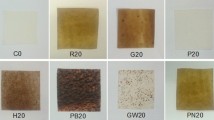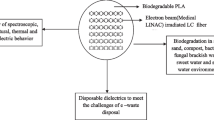Abstract
In this study, we utilized a solar energy tube for the processing of lemon residues, which was used as a filler in polyester-based green composites. Lemon residues powder (LRP) was obtained by in-water grinding. We evaluated the biodegradability, morphology, and thermal and mechanical properties of composite materials made by melt-blending glycidyl methacrylate-grafted poly(butylene adipate-co-terephthalate) (PBAT-g-GMA) with coupling agent-treated lemon residues powder (TLRP). Composites containing PBAT-g-GMA and TLRP exhibited noticeably superior mechanical properties due to the significant compatibility between these two components. The dispersion of TLRP in the PBAT-g-GMA matrix was highly homogeneous as a result of ether formation between PBAT-g-GMA and TLRP and the consequent creation of branched and cross-linked macromolecules. Water resistance of PBAT-g-GMA/TLRP was greater than that of PBAT/LRP, although the weight loss of composites buried in soil compost indicated that both were biodegradable, even at high levels of LRP or TLRP substitution. The PBAT-g-GMA/TLRP membranes were more biodegradable than those made of PBAT, implying a strong connection between these characteristics and biodegradability.








Similar content being viewed by others
References
Jiang N, Jin LF, Silva JATD, Islam MZ, Gao HW, Liu YZ, Peng SA (2014) Activities of enzymes directly related with sucrose and citric acid metabolism in citrus fruit in response to soil plastic film mulch. Sci Hortic 168:73–80
Robles JM, Botía P, Pérez-Pérez JG (2017) Sour orange rootstock increases water productivity in deficit irrigated ‘Verna’ lemon trees compared with Citrus macrophylla. Agric Water Manag 186:98–107
Interdonato R, Rosa M, Nieva CB, González JA, Hilal M, Prado FE (2011) Effects of low UV-B doses on the accumulation of UV-B absorbing compounds and total phenolics and carbohydrate metabolism in the peel of harvested lemons. Environ Exp Bot 70:204–211
Fu JT, Chang YH, Shiau SY (2015) Rheological, antioxidative and sensory properties of dough and Mantou (steamed bread) enriched with lemon fiber. LWT Food Sci Technol 61:56–62
Sendra E, Fayos P, Lario Y, Fernández-López J, Sayas-Barberá E, Pérez-Alvarez JA (2008) Incorporation of citrus fibers in fermented milk containing probiotic bacteria. Food Microbiol 25:13–21
Hilal M, Rodríguez-Montelongo L, Rosa M, Gallardo M, González JA, Interdonato R, Rapisarda VA, Prado FE (2008) Solar and supplemental UV-B radiation effects in lemon peel UV-B-absorbing compound content—seasonal variations. Photochem Photobiol 84:1480–1486
Sharma K, Mahato N, Cho MH, Lee YR (2017) Converting citrus wastes into value-added products: economic and environmentally friendly approaches. Nutrition 34:29–46
Gómez B, Gullón B, Yáñez R, Schols H, Alonso JL (2016) Prebiotic potential of pectins and pectic oligosaccharides derived from lemon peel wastes and sugar beet pulp: a comparative evaluation. J Funct Foods 20:108–121
Sabiha MA, Saidur R, Mekhilef S, Mahian O (2015) Progress and latest developments of evacuated tube solar collectors. Renew Sustain Energy Rev 51:1038–1054
Misha S, Mat S, Ruslan MH, Salleh E, Sopian K (2016) Performance of a solar-assisted solid desiccant dryer for oil palm fronds drying. Sol Energy 132:415–429
Yen HY, Lin YC (2017) Green extraction of Cymbopogon citrus essential oil by solar energy. Ind Crops Prod 108:716–721
Sokhansefat T, Kasaeian A, Rahmani K, Heidari AH, Aghakhani F, Mahian O (2018) Thermoeconomic and environmental analysis of solar flat plate and evacuated tube collectors in cold climatic conditions. Renew Energy 115:501–508
Tian Z, Perers B, Furbo S, Fan J (2018) Analysis and validation of a quasi-dynamic model for a solar collector field with flat plate collectors and parabolic trough collectors in series for district heating. Energy 142:130–138
Wu D, Hakkarainen M (2015) Recycling PLA to multifunctional oligomeric compatibilizers for PLA/starch composites. Eur Polym J 64:126–137
Lai SM, Kao YH, Liu YK, Chiu FC (2016) Preparation and properties of luffa fiber- and kenaf fiber-filled poly(butylene succinate-co-lactate)/starch blend-based biocomposites. Polym Test 50:191–199
Wang LF, Rhim JW (2016) Grapefruit seed extract incorporated antimicrobial LDPE and PLA films: effect of type of polymer matrix. LWT Food Sci Technol 74:338–345
Yates MR, Barlow CY (2013) Life cycle assessments of biodegradable, commercial biopolymers—a critical review. Resour Conserv Recycl 78:54–66
Harding KG, Gounden T, Pretorius S (2017) “Biodegradable” plastics: a myth of marketing? Procedia Manuf 7:106–110
Shi XQ, Ito H, Kikutani T (2005) Characterization on mixed-crystal structure and properties of poly(butylene adipate-co-terephthalate) biodegradable fibers. Polymer 46(25):11442–11450
Oliveira TA, Oliveira RR, Barbosa R, Azevedo JB, Alves TS (2017) Effect of reprocessing cycles on the degradation of PP/PBAT-thermoplastic starch blends. Carbohydr Polym 168:52–60
Hazer B (2014) The properties of PLA/oxidized soybean oil polymer blends. J Polym Environ 22(2):200–208
Allı S, Aydın RST, Allı A, Hazer B (2015) Biodegradable poly(ε-caprolactone)-based graft copolymers via poly(linoleic acid): in vitro enzymatic evaluation. J Am Oil Chem Soc 92(3):449–458
Sanal T, Kocak I, Hazer B (2017) Synthesis of comb-type amphiphilic graft copolymers derived from chlorinated poly(e-caprolactone) via click reaction. Polym Bull 74(4):977–995
Hazer B, Baysal BM, Koseoglu AG, Besirli N, Taskın E (2012) Synthesis of polylactide-b-poly (dimethyl siloxane) block copolymers and their blends with pure polylactide. J Polym Environ 20(2):477–484
Wei D, Wang H, Ziaee Z, Chibante F, Zheg A, Xiao H (2016) Non-leaching antimicrobial biodegradable PBAT films through a facile and novel approach. Mater Sci Eng, C 58:986–991
Stloukal P, Verney V, Commereuc S, Rychly J, Matisova-Rychlá L, Pis V, Koutny M (2012) Assessment of the interrelation between photooxidation and biodegradation of selected polyesters after artificial weathering. Chemosphere 88(10):1214–1219
Cardoso LC, Santos JCP, Camilloto GP, Miranda AL, Druzian JI, Guimarães AG (2017) Development of active films poly (butylene adipate co-terephthalate)—PBAT incorporated with oregano essential oil and application in fish fillet preservation. Ind Crops Prod 108:388–397
García-García D, Carbonell A, Samper MD, García-Sanoguera D, Balart R (2015) Green composites based on polypropylene matrix and hydrophobized spend coffee ground (SCG) powder. Compos Part B Eng 78:256–265
Rashidova SS, Voropaeva IL, Mukhamedzhanova MY, Reshetnikova IV, Ruban IN (2002) Rheological properties of concentrated solutions of mixtures of lemon pectin with flexible-chain vinyl polymers. Russ J Appl Chem 75(7):1136–1140
López OV, Versino F, Villar MA, García MA (2015) Agro-industrial residues from starch extraction of Pachyrhizus ahipa as filler of thermoplastic corn starch films. Carbohydr Polym 134:324–332
Hazer B (1996) Polyw-hydroxynonanoate) and polystyrene or poly(methyl methacrylate) graft copolymers: microstructure characteristics and mechanical and thermal behavior. Macromol Chem Phys 191(2):431–441
Wu CS, Hsu YC, Yeh JT, Liao HT, Jhang JJ, Sie YY (2013) Biocompatibility and characterization of renewable agricultural residues and polyester composites. Carbohydr Polym 94:584–593
Shih YF, Lee WC, Jeng RJ, Huang CM (2006) Water bamboo husk-reinforced poly(butylene succinate) biodegradable composites. J Appl Polym Sci 99(1):188–199
Wu CS, Liao HT, Cai YX (2017) Characterisation, biodegradability and application of palm fibre-reinforced polyhydroxyalkanoate composites. Polym Degrad Stab 140:55–63
Ravichandran CT, Revathi E, Ulaganathan S (2016) Synthesis and characterization of novel biodegradable aliphatic and aromaticcopolyesterspoly ethylene succinate-co-ethylenesebacate), poly (butylene adipate-co-butylene terephthalate). IJAASR 1(2):17–21
Fan X, Jia X, Liu J, Liu Y, Zhang H, Zhang B, Zhang H, Zhang Q (2017) Morphology evolution of poly(glycidyl methacrylate) colloids in the 1,1-diphenylethene controlled soap-free emulsion polymerization. Eur Polym J 92:220–232
Rondeau-Mouro C, Bouchet B, Pontoire B, Robert P, Mazoyer J, Buléon A (2003) Structural features and potential texturising properties of lemon and maize cellulose microfibrils. Carbohydr Polym 53(3):241–252
Liu XL, Tsunega S, Jin RH (2017) Unexpected “Hammerlike Liquid” to pulverize silica powders to stable sols and its application in the preparation of sub-10 nm SiO2 hybrid nanoparticles with chirality. ACS Omega 2(4):1431–1440
Wu CS (2015) Preparation, characterisation, and controlled-release of biodegradable polyester and marine-algae composite. J Polym Environ 23(3):356–366
Wu CS, Liao HT, Jhang JJ, Yeh JT, Huang CY, Wang SL (2013) Thermal properties and characterization of surface-treated RSF-reinforced polylactide composites. Polym Bull 70(11):3221–3239
Shih YF, Huang CC, Chen PW (2010) Biodegradable green composites reinforced by the fiber recycling from disposable chopsticks. Mater Sci Eng, A 527:1516–1521
Maslinda AB, Abdul Majid MS, Ridzuan MJM, Afendi M, Gibson AG (2017) Effect of water absorption on the mechanical properties of hybrid interwoven cellulosic–cellulosic fibre reinforced epoxy composites. Compos Struct 167:227–237
Acknowledgements
The author thanks the National Science Council (Taipei City, Taiwan, ROC) for financial support (MOST 106-2221-E-244 -008 -MY2).
Author information
Authors and Affiliations
Corresponding author
Rights and permissions
About this article
Cite this article
Wu, CS. Solar energy tube processing of lemon residues for use as fillers in polyester-based green composites. Polym. Bull. 75, 5745–5761 (2018). https://doi.org/10.1007/s00289-018-2359-1
Received:
Revised:
Accepted:
Published:
Issue Date:
DOI: https://doi.org/10.1007/s00289-018-2359-1




